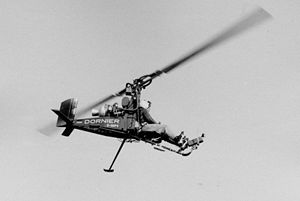Dornier Do 32
| Do 32 | |
|---|---|

| |
| Role | Ultra light helicopter |
| National origin | Federal German Republic |
| Manufacturer | Dornier Werke GmbH |
| First flight | 29 June 1962 |
| Number built | 4 |
The Dornier Do 32E was a simple, collapsible one-man helicopter, designed for military use in Germany in the 1960s. Despite initial hopes of large orders and some proposed civilian roles, only three flew.
Development[]
In the early 1960s, the German Army had an interest in a small helicopter for observation and communications duties that could be folded up compactly enough to be carried in a trailer pulled by a jeep. The Do 32, like several other light helicopters of the time such as the Fairey Ultra-light Helicopter and the Sud-Ouest Djinn, used rotor tip jets to drive the rotor blades. The advantage of tip drive is the absence of torque reaction, making a tail rotor unnecessary, saving weight and simplifying control of the aircraft. Dornier used a small gas turbine to drive a compressor, which fed air out through tubes in the rotors to the tips.[1]
The Do 32 was structurally very simple, with a square section, tapering fuselage behind the pilot. The turbine and compressor were placed on top of the fuselage, immediately behind the rotor pylon. Its exhaust impinged upon a large rectangular rudder, built to resist thermal stresses, for yaw control. The horizontal tailplane was swept. The pilot sat in front of the rotor pylon, on a simple seat, carried on the lower longerons. He controlled the plane of the two-bladed rotor directly with a long curved hanging arm, and its pitch with a conventional collective pitch lever by his left side. The rudder pedals were almost straight out in front of him on a strut that also carried, beyond his feet, some simple instruments. This member also formed part of the simple three-legged undercarriage, each strut ending with an unsprung foot.[1]

The Do 32 first flew on 29 June 1962,[1] and much flight testing was done with this aircraft and two further prototypes. The aircraft was also stowed in a trailer, transported, unfolded and flown. The heavy rotor could be spun up before takeoff with zero pitch, containing enough energy for a rapid initial vertical climb or jump start, autogyro fashion.[2] All three were eventually lost in accidents with different causes. Though Dornier had hopes of large Army orders, none followed. Agricultural applications were considered, and there was a design project for the Do 32Z, a two-seat version with a bigger engine,[1] but no more manned Do 32s flew. The unflown fourth prototype is on display at the Deutsches Museum, painted as the first prototype D-HOPA. The Do 32U was a pilotless version of the Do 32E, very similar, apart from the missing seat. The Do 32K, developed into the Do 34, was also an unmanned drone with compressed air-driven rotors, but without a fuselage.
Operator[]
Specifications[]
Data from Green 1964, p. 255
General characteristics
- Crew: one
- Length: 3.42 m (11 ft 3 in) fuselage
- Height: 1.89 m (6 ft 2 in)
- Empty weight: 147 kg (325 lb)
- Gross weight: 270 kg (596 lb)
- Max takeoff weight: 321 kg (707 lb)
- Powerplant: 1 × BMW 6012L gas turbine driving compressor, 67 kW (90 hp)
- Main rotor diameter: 7.5 m (24 ft 7 in)
Performance
- Maximum speed: 119 km/h (74 mph, 64 kn)
- Cruise speed: 100 km/h (62 mph, 54 kn)
- Range: 90 km (56 mi, 49 nmi)
- Endurance: 50 min
- Rate of climb: 4.0 m/s (780 ft/min) maximum inclined rate
See also[]
Related development
Aircraft of comparable role, configuration, and era
- Gyrodyne Rotorcycle
- XH-26 Jet Jeep
Notes[]
- ^ a b c d Green 1964, p. 255
- ^ Do 32 in action
References[]
| Wikimedia Commons has media related to Dornier Do 32. |
- Green, William (1964). Observer's book of aircraft. London: Frederick Warne & Co. Ltd.
- "YouTube: Do 32 in action". Retrieved 2010-04-01.
- Abandoned military aircraft projects of Germany
- Dornier aircraft
- Experimental helicopters
- 1960s German military aircraft
- 1960s German helicopters
- Single-turbine helicopters
- Tipjet-powered helicopters
- Aircraft first flown in 1962